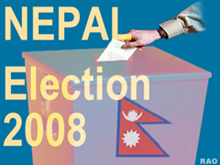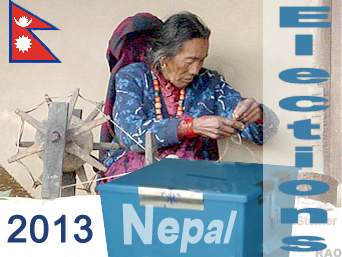|
|
| Nepal: History |
|
 |
| 21st Century |
| 2007 |
|
|
![]() January
9, 2007: Interim Constitution
January
9, 2007: Interim Constitution
The
ruling seven-party alliance SPA and the Maoists agreed to promulgate the
interim constitution on January 15, 2007.
![]() January
11, 2007: Interim Paliament
January
11, 2007: Interim Paliament
Top
leaders of the four major political parties reached an agreement to share
the remaining 48 seats in the interim legislature-parliament among the
seven-party alliance and the CPN-Maoist. According to the understanding
reached during a meeting held at the Prime Minister's official residence
at Baluwatar, the Nepali Congress, CPN-UML and CPN-Maoist will get 10 seats
each, Nepali Congress (Democratic) six, while Nepal Sadbhavana Party (Anandi
Devi), Nepal Workers' and Peasants' Party, Janamorcha Nepal and United
Left Front will get three seats each out of the 48 seats, initially allocated
for civil society.
![]() April
2, 2007: Maoists join the interim government
April
2, 2007: Maoists join the interim government
The
former Maoist rebels were sworn into a new interim government, in a major
step forward for a peace process that ended a decade of civil war.
![]() June
13, 2007: Electoral bills passed. Elections announced for Nov. 22, 2007.
June
13, 2007: Electoral bills passed. Elections announced for Nov. 22, 2007.
![]() August
3, 2007: Nepal uneils new national anthem
August
3, 2007: Nepal uneils new national anthem
![]() September
18, 2007: Maoists quit the interim government
September
18, 2007: Maoists quit the interim government
The
Maoists quit the government and launch the first phase of their so
called "street revolt". The CPN (M) will boycott the Nov 22 elections.
![]() December
24, 2007:
Seven-Party Alliance and Maoists
reached agreement to abolish the monarchy
December
24, 2007:
Seven-Party Alliance and Maoists
reached agreement to abolish the monarchy
The
Seven-Party Alliance has reached a 23-point agreement. Many of the commitments
in the new agreement have been made before: release of payments to Maoist
combatants, discharge of those disqualified in verification by UNMIN, and
deliberations in the special committee to consider the supervision, integration
and rehabilitation of the Maoist combatants.
A
commitment was made to a federal democratic republic and the modification
of the electoral system.
![]() December
28, 2007: Interim Parliament voted to abolish Nepal's monarchy
December
28, 2007: Interim Parliament voted to abolish Nepal's monarchy
Out
of 321 parliamentarians, 270 voted for the abolition of the monarchy and
three voted against. The rest were absent or abstained.
![]() December
30, 2007: Maoists rejoin Nepal government
December
30, 2007: Maoists rejoin Nepal government
Prime
Minister Girija Prasad Koirala appointed five Maoist leaders as ministers
to portfolios that Maoists had held before they quit the interim cabinet
on 18 September 2007.
| 2008 |
|
|
 |
|
 |
![]() May
28, 2008: Declaration of Nepal as a federal democratic republic
May
28, 2008: Declaration of Nepal as a federal democratic republic
Nepal
has become the world's newest federal democratic republic, ending 240 years
of monarchy. The Constituent Assembly (CA) meeting in Kathmandu voted
to abolish royal rule. 560 out of 564 CA members
voted for a republic and against the monarchy.
![]() June
11, 2008: The former king of Nepal, Gyanendra, has left Narayanhiti
palace in the heart of Kathmandu. Mr Shah, Ex-king Gyanendra's name as
ordinary citizen of the republic of Nepal, has announced that he would
not leave the country and go into exile.
June
11, 2008: The former king of Nepal, Gyanendra, has left Narayanhiti
palace in the heart of Kathmandu. Mr Shah, Ex-king Gyanendra's name as
ordinary citizen of the republic of Nepal, has announced that he would
not leave the country and go into exile.
![]() July
21, 2008: Nepal's first President: The Constituent Assembly elected
Dr Ram Baran Yadav as the first President of the Federal Democratic Republic
of Nepal, in a secret ballot. Dr Yadav is General Secretary of the Nepali
Congress Party.
July
21, 2008: Nepal's first President: The Constituent Assembly elected
Dr Ram Baran Yadav as the first President of the Federal Democratic Republic
of Nepal, in a secret ballot. Dr Yadav is General Secretary of the Nepali
Congress Party.
![]() August
15, 2008: Nepal's first Prime Minister: Members of the parliament have
elected the CPN-Maoist leader Pushpa Kamal Dahal (Prachanda) as the first
Prime Minister of the Federal Republic of Nepal.
August
15, 2008: Nepal's first Prime Minister: Members of the parliament have
elected the CPN-Maoist leader Pushpa Kamal Dahal (Prachanda) as the first
Prime Minister of the Federal Republic of Nepal.
| 2013 |
 |
|
| 2015 |
June 8, 2015
Agreement on a new constitution for Nepal
The destructive earthquake on April 25, 2015, cleared the way for the political parties to forge consensus on the contentious issues. The parties reached the long-awaited agreement after a series of dialogues and renegotiations.
The major political parties signed a 16-point agreement on the main topics of the new constitution.
The Agreement is a major milestone in the country's democratic development. This achievement is particularly laudable as it was reached amid challenging circumstances caused by the major earthquakes of April and May 2015.
September 20, 2015
Nepal adopts new constitution
Nepal's President Ram Baran Yadav announced the adoption of the constitution during a Constituent Assembly meeting. The new constitution is the first to be drafted by elected representatives.
Some ethnic minorities like the Tharu und the Terai-Madhes (Madhesi) communities, mainly from Nepal's southern Terai plains, are deeply unhappy at the proposed boundaries of the new provinces.
| more information |
|
 |